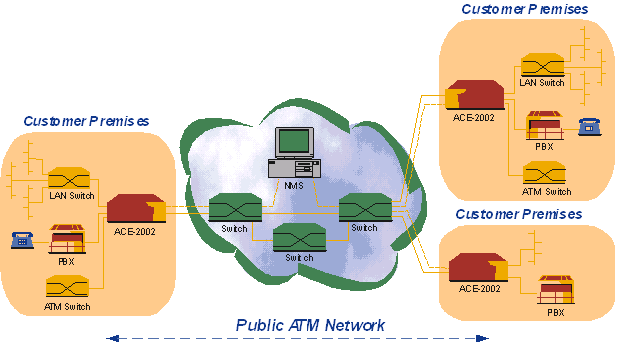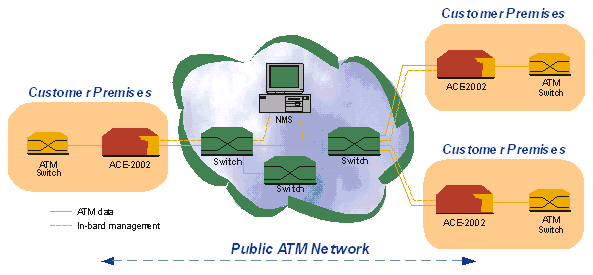|





RAD Data Communications ACE-2002
RAD ACE-2002 Network Termination Unit Features
 | Multiservice/ATM demarcation device or an enterprise access
concentrator
 | Offers converged WAN services in a fully ATM-featured product
 | Seamless migration of traditional services (LAN, voice) to ATM
 | Provides a service platform for router, PBX, LAN, video codec and
other corporate device connections
 | Offers advanced bandwidth and traffic management capabilities to
ensure high utilization of the ATM links while preserving QoS
 | Implements ITU-T I.610 OAM standard to provide end-to-end service
control
 | Supports all ATM service categories: CBR, VBR (rt and nrt), UBR and
ABR, UBR+
 | High resilience due to ATM uplinks protection and dual hot-swappable
power supplies
 | Managed either inband or out-of-band
 | Managed by RADview-HPOV or other network management applications
 | Features a wide variety of ATM UNI modules, including E1/T1, E3/T3 and
STM-1/OC-3 modules
 | Offers a wide range of non-ATM modules, including LAN (10/100BaseT)
and CES (E1/T1, 4xE1/T1, E3/T3)
 | Compact, 1U high; suitable for mounting in 19" racks |
| | | | | | | | | | | |
RAD ACE-2002 Description
 | ACE-2002 is a multiservice access concentrator that can be used as a
carrier-owned demarcation device or as a corporate concentrator
connected to the public ATM network.
 | As a demarcation device, ACE-2002 enables carriers and service
providers to define the boundary between their ATM public services and
the customer private network. A clear demarcation point at the customer
premises increases service reliability, improves network efficiency and
ensures end-to-end QoS support.
 | ACE-2002 can be used as a demarcation device for native ATM or for
legacy services, such as voice or LAN.
 | ACE-2002 enables the extension of ATM network facilities up to the
customer premises. These facilities include: advanced traffic management
(shaping, policing) and full OAM flow support. In addition, the wide
range of ATM modules further enhances the flexibility of service
offerings.
 | When used as an interworking device, ACE-2002 enables smooth migration
of legacy equipment such as PBXs and routers to operate over ATM
networks. Using multi-port modules and up to three user ports, ACE-2002
can be used as a concentrator for medium to large corporations. The unit
enables different types of corporate traffic to pass over public
networks in the most efficient way. |
| | | |
TRAFFIC MANAGEMENT
 | ACE-2002 operation modes:
 | Monitoring: The unit monitors and gathers statistical information
on the user and the network traffic
 | Policing: The unit compares the user traffic with the Service
Level Agreement (SLA) parameters. In case the user traffic exceeds
the SLA parameters, violating cells can be tagged or discarded. |
|
|
TRAFFIC SHAPING
IMPROVED RELIABILITY
 | ACE-2002 provides improved service reliability and resilience using
different built-in mechanisms. The first one, OAM (Operation,
Administration and Maintenance) enhances ATM services QoS. It includes
alarm surveillance (AIS, RDI), continuity check, performance monitoring
and loopback activation. The second mechanism is ATM link protection.
The third provides hot swapping capability of user and network modules,
and the redundant power supplies.
 | ACE-2002 OAM support complies with I.610 standard. AIS and RDI (part
of standard) are system indicators for faulty conditions in the network.
In case these indicators are detected in user or network modules,
ACE-2002 alerts the network management system.
 | Another mechanism to check the service availability is the continuity
check. ACE-2002 sends a cell periodically over a predefined VP or VC and
verifies that the VP or VC is activated.
 | Both AIS, RDI and continuity check can be activated on each open VP
and VC defined in the ACE-2002 database.
 | ACE-2002 monitors the current performance management (PM)
characteristics of the ATM network. The monitoring includes end-to-end
measurement of QoS parameters, such as error rate and cell loss ratio.
ACE-2002 can generate F4/F5 loopback cells (LB) on up to 128 VPs or VCs.
 | ACE-2002 supports SDH/SONET mechanisms for fault isolation and system
fault alerts - F1-F5. F1-F3 layers enable performance monitoring and
fault localization on user and network physical links. F4-F5 layers
enable the same functionality on the ATM layer. Using the loopback
option, ACE-2002 can measure minimum, maximum and average delay and
delay variation. The loopback function can also be used for fault
isolation. The loopback cells can be sent with source and destination
address and may be looped at any network element that was pre-assigned
with a loopback point address.
 | In order to improve the product's resilience, ACE-2002 can be
connected to the public network from two different modules.
 | ACE-2002 includes two protection mechanisms: A uni- and bi-directional
ASP 1+1 physical layer protection mechanism that allows the last
physical segment from the service exchange to the customer premises to
be protected (based on standard transport methods, such as SDH or SONET).
 | ACE-2002 supports both NNI and UNI cell headers with full bit range of
VPI/VCI fields. ACE-2002 can support up to 1024 connections, VPC and/or
VCC. This capability enables using ACE-2002 as a concentrator for large
corporate networks or as a junction between two public networks.
 | To increase the QoS, ACE?2002 includes VP tunneling. This enables
bundling multiple VCCs into a single VPC, while maintaining all the VCC
QoS characteristics and OAM (Operation, Administration and Maintenance)
capabilities at F4 and F5 layers.
 | ACE-2002 supports up to 30 VP tunnels. Each tunnel can be shaped
either as a CBR or VBR connection. It can be defined with end-to-end OAM
flow and act as a regular VP in the public network.
 | To protect the public network from over-subscription and to maximize
available network resources, it is beneficial for both user and service
provider to agree upon a Service Level Agreement (SLA) contract. To
ensure the contract is honored by both sides, ACE-2002 collects
information on the various parameters mentioned in the SLA. It also
processes the data in real time and converts it into statistical
information. The statistics are collected every 15 minutes for 24 hours
(or a total of 96 intervals). All detected events are logged and time
stamped on a non-volatile memory. The information is collected by
management systems in the network. It can be used later for fair billing
accounts.
 | To send long frames (mainly IP traffic) over ATM networks efficiently,
ACE-2002 supports Early Packet Discard (EPD) and Partial Packet Discard
(PPD) mechanisms. In case cells are lost or discarded, and are part of a
long frame, ACE-2002 can drop the rest of the cells that belong to the
same frame. This prevents overload of the network resources by non-valid
cells.
 | ACE-2002 supports Call Admission Control (CAC), which prevents network
congestion by checking the network resources when a request to open a
new connection is received. In case the network resources are
insufficient, the request for a new connection is rejected.
 | ACE-2002 can be managed either locally or remotely using different
ports and applications:
 | ACE-2002 can be managed locally by connecting an ASCII terminal to
the RS-232 port on the front panel. The same port can be used to
connect a dial?up modem so ACE-2002 can be remotely managed.
ACE-2002 supports PPP protocol for SNMP management over RS-232.
 | ACE-2002 can be managed locally via a dedicated Ethernet port,
located on the front panel.
 | A management workstation located anywhere in the ATM public
network can be connected to a remote customer device and perform
configuration, monitoring and diagnostics using a dedicated VC.
 | n ACE-2002 can be managed by and report to up to 8 different
managers simultaneously. This enables viewing the network status
from different locations. |
| | |
 | The RADview-HPOV network management application provides the
capability to monitor, configure, fault isolate and present network
statistics using a graphical, user-friendly display. This UNIX-based
application alerts in real time on service availability and faulty
network conditions. The real time clock of the management application is
synchronized with all the managed units. This enables determining the
real time of events and provides the ability to sort events
chronologically. Also, the statistical collection of events can be
synchronized so that the 15-minute intervals of statistical information
can be sorted in a realistic sequence. The system events and the
statistical information are registered in a log file. The RADview
application can store a complete pre-defined configuration of ACE-2002
to shorten and simplify its field installation. After ACE-2002 is
installed, it is possible to remotely download the complete
configuration from anywhere in the network. |
| | | | | | | | | | | | | | |
ACE-2002 Interworking Modules
|
Module Name
|
Description
|
Connector Type
|
|
ACE-M/ETH
|
Ethernet/Fast Ethernet
|
RJ-45
|
|
ACE-M/CES/4E1
|
|
RJ-45
|
|
ACE-M/CES/4E1/CX
|
|
BNC
|
|
ACE-M/CES/4T1
|
|
RJ-45
|
|
ACE-M/ETH/CES/E3
|
|
|
|
ACE-M/ETH/CES/T3
|
|
|
ACE-2002 ATM Modules
|
Module Name
|
Description
|
Data Rates
|
Connector Type
|
Typical Distance
|
Wavelength
|
Optical Output |
Sensitivity
|
|
ACE-M/E3
|
|
|
BNC
|
150m / 492 ft
|
-
|
-
|
-
|
|
ACE-M/FC13L/E3
|
|
|
FC
|
40 km / 25 mi
|
1300 nm
|
- |
- |
|
ACE-M/T3
|
|
|
BNC
|
150m / 492 ft
|
-
|
-
|
-
|
|
ACE-M/FC13L/T3
|
|
|
FC
|
40 km / 25 mi
|
1300 nm
|
- |
- |
|
ACE-M/CX/BNC/155
|
STM-1, electrical
|
|
BNC
|
150m / 492 ft
|
-
|
-
|
-
|
|
ACE-M/SC13M/155
|
STM-1/OC-3
multimode
|
|
Duplex SC
|
2 km / 1.25 mi
|
1300 nm
|
-18 dBm
|
-29 dBm
|
|
ACE-M/ST13L/155
|
STM-1/OC-3
single-mode
|
|
ST-SC
|
40 km / 25 mi
|
1300 nm
|
-12 dBm
|
-32 dBm
|
|
ACE-M/FC13L/155
|
STM-1/OC-3
single-mode
|
|
FC
|
40 km / 25 mi
|
1300 nm
|
-12 dBm
|
-32 dBm
|
|
ACE-M/SC13L/155
|
STM-1/OC-3
single-mode
|
|
Duplex SC
|
40 km / 25 mi
|
1300 nm
|
-12 dBm
|
-32 dBm
|
|
ACE-M/FC13LH/155
|
STM-1/OC-3
single-mode, long-haul
|
|
FC
|
60 km / 38 mi
|
1300 nm
|
-2 dBm
|
-34 dBm
|
|
ACE-M/FC15LH/155
|
STM-1/OC-3
single-mode, long-haul
|
|
FC
|
110 km / 68 mi
|
1550 nm
|
-2 dBm
|
-34 dBm
|
|
ACE-M/FC/SF1/155
|
WDM, single fiber,
STM-1/OC-3
|
|
FC
|
40 km / 25 mi
|
Tx 1300 nm
Rx 1550 nm
|
-12 dBm
|
-29 dBm
|
|
ACE-M/FC/SF2/155
|
WDM, single fiber,
STM-1/OC-3
|
|
FC
|
40 km / 25 mi
|
Tx 1550 nm
Rx 1300 nm
|
-12 dBm
|
-29 dBm
|
|
ACE-M/ST/SF1/155
|
WDM, single fiber,
STM-1/OC-3
|
|
ST
|
40 km / 25 mi
|
Tx 1300 nm
Rx 1550 nm
|
-12 dBm
|
-29 dBm
|
|
ACE-M/ST/SF2/155
|
WDM, single fiber,
STM-1/OC-3
|
|
ST
|
40 km / 25 mi
|
Tx 1550 nm
Rx 1300 nm
|
-12 dBm
|
-29 dBm
|
|
ACE-M/E1
|
|
|
RJ-45, 8-pin
BNC, 75W
|
- |
- |
- |
- |
|
ACE-M/T1
|
|
|
RJ-45, 8-pin
|
- |
- |
- |
- |
|
ACE-101/UTP/25
|
|
|
RJ-45
|
- |
- |
- |
- |
Applications for the ACE-2002

Figure 1. ACE-2002 as a Multiservice Access Concentrator

Figure 2. ATM NTU Application
Ordering the RAD ACE-2002 ATM Network Termination Unit
ACE-2002/#/@/&
ATM Network Termination Unit
# Specify power supply type
AC for 100-250 VAC
48 for -48 VDC
@ Specify R for redundant power supply (same
as the first)
& Specify SPR for traffic shaping option
RM-11
Hardware for mounting units in a 19" rack
Related RAD ACE-2002 information: ACE-2000
data sheet (pdf)
ACE Modules
 | 4 FRAME RELAY MODULE FOR ACE-202/2002 |
 | 4 FRAME RELAY MODULE FOR ACE-202/2002 |
 | 4 HDLC/RS530 MODULE FOR ACE-202/2002 |
 | 4 HDLC/V35 MODULE FOR ACE-202/2002 |
 | CES MODULE FOR ACE-2002/202, 4 E1 |
 | CES MODULE FOR ACE-2002/202, 4 E1, COAX |
 | CES MODULE FOR ACE-2002/202, 4 BALANCED T1
CES (RJ45) |
 | E3 MODULE FOR ACE-2002/202 |
 | ETHERNET MODULE FOR ACE-2002/202 |
 | ACE MODULE, ETHERNET + CES/E1 FOR
ACE-2002/202 |
 | ETHERNET/FAST ETHERNET & E3 CES PORT
MODULE FOR |
 | MODULE, ETH + CES/T1 FOR ACE-2002/202 |
 | INTERNETWORKING MODULE FOR ACE 2002/202 |
 | MODULE 1300NM LASER, FC CONN, 155 MBPS FOR
ACE-2002 |
 | ACE-2002 MODULE, IMA, 4XE1 |
 | ACE-2002 MODULE, IMA 4 X T1 |
 | MODULE 1300NM LASER 155 MBS FOR 2002 |
 | STM-1/OC3 MODULE |
 | STM-1/OC3 MODULE |
 | SINGLE MODE MODULE, 622MBPS, 1310NM SC
CONN LONG HAUL LASER, |
 | MODULE 1300NM 155MBS FOR 2002 |
 | DUAL STM-1/OC3 MODULE |
 | STM-1/OC3 MODULE |
 | MULTMODE ATM MODULE 622MBPS, SC CONN 1310
NM FOR |
 | ATM UNI MODULE, SM, SF1, ST, 155 MBPS FOR
ACE-2002 |
 | ATM UNI MODULE, SM, SF1, ST, 155 MBPS FOR
ACE-2002 |
 | T1 MODULE FOR ACE-2002/202 |
 | T3 MODULE FOR 2002/202 |
 | MODULE FOR ACE-2002/202, 25.6 MBPS, UTP |
RAD D:
RAD Data sheet on ACE-2002 Quad T1 modules
RAD Data sheet on ACE-2002 LAN module:
RAD Data sheet on other available ACE-2002
|
